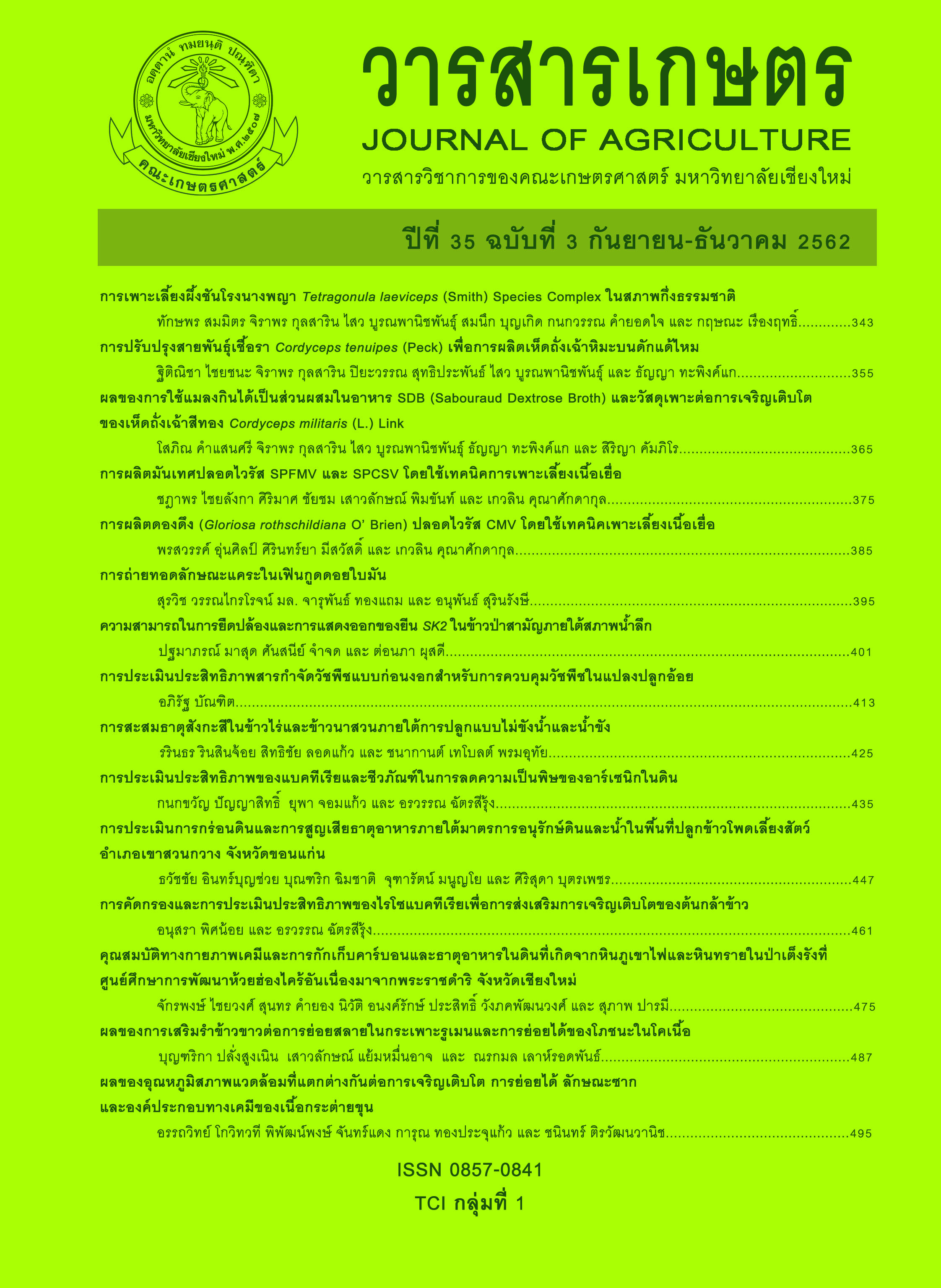Effects of White Rice Bran Supplementation on Ruminal Degradability and Nutrient Digestibility in Beef Cattle
Main Article Content
Abstract
The aims of this study were to analyse chemical compositions, ruminal degradability and nutrient digestibility in beef cattle of concentrate with different level of white rice bran. Concentrate with different level of white rice bran including T1 (0%), T2 (10%), T3 (20%) and T4 (30%) were formulated. Chemical composition were analysed by proximate analysis. Four fistulated Thai native beef cattles were used for ruminal degradability and nutrients digestibility. Ruminal degradability were analysed by nylon bag technique at 2, 4, 8, 10, 12, 24, 48, 72 and 96 h. The nutrients digestibility were analysed by in vivo digestibility. The experimental design of in vivo digestibility was 4x4 Latin square designs. The data of feed intake, refusal and fecal were carefully recorded. The results found that DM and OM decrease by level of white fine rice bran (P<0.05) EE T3 (20%) and T4 (30%) were the highest significantly (P<0.05). Even though the DM disappearance (%) were not significantly different. The soluble fraction (a) of T1 (0%) was the lowest (P<0.05). Furthermore, CP digestibility was quadratic decreased (P<0.05). NDF and ADF nutrient digestibility of T2 (10%) was significantly highest (P<0.05). These results are concluded that concentrate containing white rice bran 10% can be supplement in cattle.
Article Details
References
AOAC. 2000. Official Methods of Analysis of AOAC International. 17th ed. AOAC International, Gaithersburg, Maryland.
Bhatt, R.S., S.R. Sharma, U. Singh, D. Kumar and K.S. Risam. 2005. Effect of substituting groundnut cake with different levels of rice bran on growth and wool production of German Angora rabbits. World Rabbit Science 13(3): 179-187.
Cheva-isarakul, B. 2003. Biochemistry in Animal Science. Department of Animal Science, Faculty of Agriculture, Chiang Mai University, Chiang Mai. (In Thai)
Cone, J.W., A.H. Van Gelder and F. Dreihuis. 1997. Description of gas production profiles with a three-phasic model. Animal Feed Science and Technology 66: 31-45.
Moonmat, N., M. Otsuka, S. Udchachon and K. Sommart. 2010. Nutritive value and metabolizable energy evaluation of rice bran, kapok seed meal and coconut meal in Thai native beef cattle. Journal of Science and Technology Mahasarakham University 29(4): 382-388. (In Thai)
NRC. 2001. Nutrient Requirements of Dairy Cattle. 7th ed. National Academy Press, Washington, D.C.
Ørskov, E.R. and I. McDonald. 1970. The estimation of protein degradability in the rumen from incubation measurements weighted according to rate of passage. Journal Animal Science 92(2): 499-503.
Schneider, B.H. and W.P. Flatt. 1975. The Evaluation of Feeds Through Digestibility Experiments. University of Georgia Press, Georia, U.S.A.
Soren, N.M., R. Bhar, A.K. Chhabra and A.B. Mandal. 2004. Utilization of energy and protein in local Indian crossbred gilts fed diets containing different levels of rice bran. Asian-Australasian Journal of Animal Sciences 17(5): 688-692.
Steel, R.G.D. and J.H. Torrie. 1980. Principles and Procedures of Statistics: A Biometrical Approach. 2nd ed. McGraw-Hill, New York. 672 p.
Van Soest, P.J., J.B. Robertson and B.A. Lewis. 1991. Methods for dietary fiber, neutral detergent fiber, and nonstarch polysaccharides in relation to animal nutrition. Journal of Dairy Science 74: 3583-3597.
Wachirapakorn, C., C. Wongnen, A. Cherdthong and K. Phonsaen. 2016. Effects of dried ethanol by-product in total mixed ration on intake, digestibility, yield and milk composition of lactating cows. Journal of Agriculture 32(2): 247-259. (In Thai)
Yulistiani, D., Z.A. Jelan and J.B. Liang. 2008. Degradability of mulberry (Morus alba) and rice bran in the rumen of sheep fed different diets. Indonesian Journal of Animal and Veterinary Sciences 13(4): 264-272.


